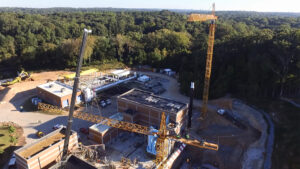Several of our industry’s best collaborative-delivery methods — namely CMAR and progressive design-build — rely on an open-book process for developing cost and pricing during preconstruction. This process is used to achieve an agreed-upon cost and, then, a price for the construction effort to proceed. In turn, the price is typically implemented either as a guaranteed maximum price (GMP) or a lump-sum contract provision to initiate and deliver construction of the project.
This approach is straightforward in principle, but we often are asked, “What, exactly, is an ‘open-book’ approach?” The answer comes down to these two fundamental definitions of “cost” and “price”:
Cost is cost is cost. Construction estimates should be based on the actual cost of work. This can mean actual labor, expenses, materials, equipment, and production rates for self-performed scope or stand-alone subcontractor quotes obtained via a best value, competitive bidding approach. In either case, all of these documentable expenditures are set forth without any add-ons — with all the assumptions underlying them clearly stated — to equal a project cost estimate.
Price includes everything else. Once a cost estimate is set forth, anything that gets added to it for a contractor’s or design-builder’s overhead, operating costs, burdens, encumbrances, profit, turnover, mark-ups, fees, charges, levies, incentives, — or whatever other term you can think of — is extra money that is added on top of actual cost to create a price.
CMAR and progressive design-build are very popular delivery methods because they allow projects to proceed on a collaborative basis in advance of a completed design or even a full project definition. Both delivery methods are typically procured on the basis of qualifications in conjunction with some form of as-bid fees for the pricing components. The cost is developed by the contractor or design-builder after project award based on several foundational principles:
The Principles of Open Book Pricing
 Transparency and validation. Costs must be developed in a completely transparent manner with no hidden amounts and nothing embedded or inflated. With transparency comes full, confidential disclosure of all the details. It’s truly an “open book.” With transparency comes third-party verification, if required.
Transparency and validation. Costs must be developed in a completely transparent manner with no hidden amounts and nothing embedded or inflated. With transparency comes full, confidential disclosure of all the details. It’s truly an “open book.” With transparency comes third-party verification, if required.
 Accuracy and completeness. For fairness to both owners and contractors or design-builders, the development of costs and price must include everything that everyone can reasonably think of, both in terms of estimate line items and also expenses and indirect costs. Leave nothing out.
Accuracy and completeness. For fairness to both owners and contractors or design-builders, the development of costs and price must include everything that everyone can reasonably think of, both in terms of estimate line items and also expenses and indirect costs. Leave nothing out.
 Realism and fairness. Open book pricing is often used to “design to budget,” but that does not mean “make it fit to budget.” Cost and pricing must be both realistic and fair to both parties. Sometimes it takes a bit of work to get there, but a realistic number means a complete and fair number.
Realism and fairness. Open book pricing is often used to “design to budget,” but that does not mean “make it fit to budget.” Cost and pricing must be both realistic and fair to both parties. Sometimes it takes a bit of work to get there, but a realistic number means a complete and fair number.
 Risk and opportunity assessment. Not everything on a project is entirely predictable, especially early in a project. Anything that is a “guess” or an undefined risk or opportunity should be quantitatively assessed and evaluated as a project contingency amount. The actual sum of the potential downside or upside — the contingency — should normally be seen as an estimated project cost before any add-ons are included to create a price.
Risk and opportunity assessment. Not everything on a project is entirely predictable, especially early in a project. Anything that is a “guess” or an undefined risk or opportunity should be quantitatively assessed and evaluated as a project contingency amount. The actual sum of the potential downside or upside — the contingency — should normally be seen as an estimated project cost before any add-ons are included to create a price.
So what happens after everyone has mutually agreed on a project’s cost, everything else is added to the number, and the price is settled? These two options are the most common:
- Moving forward under a GMP model means that actual spending during construction is monitored using the same open-book transparency principles. Any actual savings from spending under the GMP is often shared between the owner and the contractor or design-builder (this incentivizes continued efficiency) and the risk of having to spend anything over the GMP is at the contractor’s or design-builder’s risk. This is a terrific way to share any unused contingency.
- In contrast to the GMP approach, a lump-sum implementation “closes the books” after the price is agreed upon and the contractor or design-builder proceeds to construct the project at its own risk — and opportunity — for meeting the price commitment. This approach keeps things simple by eliminating the need for an ongoing auditing function during construction and the contractor or design-builder can offset risk by retaining any unspent contingency.
Of course, innumerable details accompany all of the above, but an effective open-book approach will be true to these principles. Mutual trust is the foundation of collaborative delivery — and open-book transparency is one of its best building-blocks.







